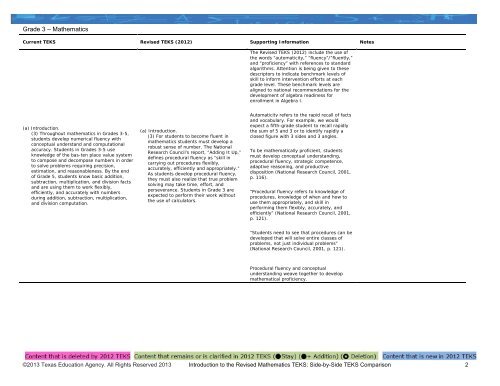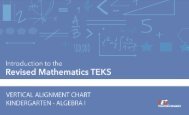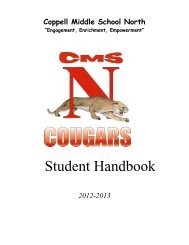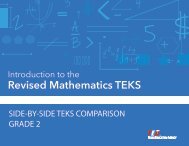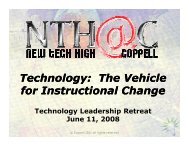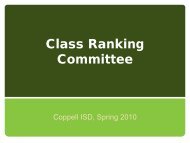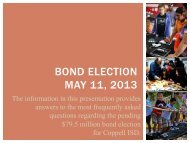SIDE-BY-SIDE TEKS COMPARISON GRADE 3 - Project Share
SIDE-BY-SIDE TEKS COMPARISON GRADE 3 - Project Share
SIDE-BY-SIDE TEKS COMPARISON GRADE 3 - Project Share
You also want an ePaper? Increase the reach of your titles
YUMPU automatically turns print PDFs into web optimized ePapers that Google loves.
Grade 3 – MathematicsCurrent <strong>TEKS</strong> Revised <strong>TEKS</strong> (2012) Supporting Information NotesThe Revised <strong>TEKS</strong> (2012) include the use ofthe words “automaticity,” “fluency”/”fluently,”and “proficiency” with references to standardalgorithms. Attention is being given to thesedescriptors to indicate benchmark levels ofskill to inform intervention efforts at eachgrade level. These benchmark levels arealigned to national recommendations for thedevelopment of algebra readiness forenrollment in Algebra I.(a) Introduction.(3) Throughout mathematics in Grades 3-5,students develop numerical fluency withconceptual understand and computationalaccuracy. Students in Grades 3-5 useknowledge of the bas-ten place value systemto compose and decompose numbers in orderto solve problems requiring precision,estimation, and reasonableness. By the endof Grade 5, students know basic addition,subtraction, multiplication, and division factsand are using them to work flexibly,efficiently, and accurately with numbersduring addition, subtraction, multiplication,and division computation.(a) Introduction.(3) For students to become fluent inmathematics students must develop arobust sense of number. The NationalResearch Council’s report, “Adding It Up,”defines procedural fluency as “skill incarrying out procedures flexibly,accurately, efficiently and appropriately.”As students develop procedural fluency,they must also realize that true problemsolving may take time, effort, andperseverance. Students in Grade 3 areexpected to perform their work withoutthe use of calculators.Automaticity refers to the rapid recall of factsand vocabulary. For example, we wouldexpect a fifth-grade student to recall rapidlythe sum of 5 and 3 or to identify rapidly aclosed figure with 3 sides and 3 angles.To be mathematically proficient, studentsmust develop conceptual understanding,procedural fluency, strategic competence,adaptive reasoning, and productivedisposition (National Research Council, 2001,p. 116).“Procedural fluency refers to knowledge ofprocedures, knowledge of when and how touse them appropriately, and skill inperforming them flexibly, accurately, andefficiently” (National Research Council, 2001,p. 121).“Students need to see that procedures can bedeveloped that will solve entire classes ofproblems, not just individual problems”(National Research Council, 2001, p. 121).Procedural fluency and conceptualunderstanding weave together to developmathematical proficiency.©2013 Texas Education Agency. All Rights Reserved 2013 Introduction to the Revised Mathematics <strong>TEKS</strong>: Side-by-Side <strong>TEKS</strong> Comparison 2


